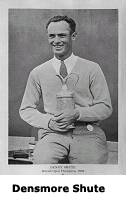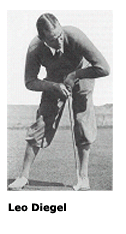|
 Shute had
three-putted the final green at Southport & Ainsdale two weeks
before to lose the Ryder Cup, but recovered well to shoot four
rounds of 73 at St Andrews and tie with compatriot Craig Wood. In
the final round, on the long 5th, the big hitting Wood had driven
into a bunker 425 yards down wind from the tee, an incredible shot
which caused Bernard Darwin to write: “That the thing happened there
is no shadow of doubt, as to how it happened I give it up”. He then
took another four to get down. Wood, the perennial runner-up, was
defeated in the 36-hole play-off, one of the three majors he lost
that way. Shute’s win was the tenth in a row for the USA. Shute had
three-putted the final green at Southport & Ainsdale two weeks
before to lose the Ryder Cup, but recovered well to shoot four
rounds of 73 at St Andrews and tie with compatriot Craig Wood. In
the final round, on the long 5th, the big hitting Wood had driven
into a bunker 425 yards down wind from the tee, an incredible shot
which caused Bernard Darwin to write: “That the thing happened there
is no shadow of doubt, as to how it happened I give it up”. He then
took another four to get down. Wood, the perennial runner-up, was
defeated in the 36-hole play-off, one of the three majors he lost
that way. Shute’s win was the tenth in a row for the USA.
Three men finished a shot behind. Defending champion Gene Sarazen,
my partner from the previous year, had taken three to get out of
Hill bunker on the short 11th in round two – in spite of his
blaster. Darwin described it as “the most dreadful bunker in all
golf”. It is so deep and Gene was so small that, for those watching
from the green, only the puffs of sand betrayed his presence. There
was an embarrassing incident when the Championship Committee had to
investigate an over zealous steward’s accusation that he had taken
four shots in the sand, without the benefit of TV replays of course.
He had actually swung his club in frustration after failing to get
out of the sand and had not made another stroke - his score of 6 was
found to be correct. In the final round he found the dreaded Hell
bunker on 14 and, in throwing caution to the winds, he left it in
and had an eight. He did not realise that the leaders were faltering
and he could play safely out of Hell. Despite his new club the St
Andrews bunkers had cost Gene a second Open. His Ryder Cup team mate
–
 Leo Diegel, had a short putt on the 18th to tie the lead, but his
suspect nerves and his unorthodox putting style let him down. If
anything it was a worse miss than the Doug Sanders putt on the same
green that cost him the 1970 Open. Did Leo miss the ball altogether
to incur that tragic extra stroke? Bernard Darwin described the
scene thus: “Finally he laid his putt apparently stone-dead in three
at the ‘Home’ hole and missed the putt by the widest possible
margin”. In his book Golf Between Two Wars Darwin said that Leo had
utterly failed to hit it, which was reasonably taken to mean that he
had not just missed the putt – he had missed the ball, although that
other doyen of commentators, Henry Longhurst, did not see it that
way. The news reels do not seem to have captured the putt, but if
Leo did have an air shot it was a very costly lapse of concentration
that was to be repeated fifty years later by his compatriot Hale
Irwin. His miss from 3 inches, repeated many times on TV, came in
the 1983 Open; He finished just one shot out of a tie with the
champion - Tom Watson. Leo Diegel, had a short putt on the 18th to tie the lead, but his
suspect nerves and his unorthodox putting style let him down. If
anything it was a worse miss than the Doug Sanders putt on the same
green that cost him the 1970 Open. Did Leo miss the ball altogether
to incur that tragic extra stroke? Bernard Darwin described the
scene thus: “Finally he laid his putt apparently stone-dead in three
at the ‘Home’ hole and missed the putt by the widest possible
margin”. In his book Golf Between Two Wars Darwin said that Leo had
utterly failed to hit it, which was reasonably taken to mean that he
had not just missed the putt – he had missed the ball, although that
other doyen of commentators, Henry Longhurst, did not see it that
way. The news reels do not seem to have captured the putt, but if
Leo did have an air shot it was a very costly lapse of concentration
that was to be repeated fifty years later by his compatriot Hale
Irwin. His miss from 3 inches, repeated many times on TV, came in
the 1983 Open; He finished just one shot out of a tie with the
champion - Tom Watson.
Leo used a long putter, the handle of which was anchored to his
waist - an early appearance of the ‘belly’ putter that is now so
popular – hence his extraordinary hunched style, with elbows out and
forearms parallel to the ground. Gene Sarazen said that he putted:
“Like a man seized with cramps”. The method was widely copied for a
while and it became known as ‘diegeling’, after Bernard Darwin
created the verb ‘to diegel’ and conjugated it – ‘I diegel, thou
diegelest, we all diegel’. (Note the similarity with the Wills
cigarette card depicting my brother George in Chapter 3). The third
man in the second placed group was the leading Britain - Syd
Easterbrook. He was the hero in the narrow victory over the
Americans in the Ryder Cup, when he had beaten Shute in the decisive
match. He was the only British player in the top six and had been in
a position to win, after starting the last round as joint leader
with Diegel, Cotton, Mitchell and Joe Kirkwood, the Australian born
Trick Shot Artist, who had also finished 4th in 1923 and would again
in1934. (He was in the top ten in four Opens) A seven at the 14th
finally put paid to Syd’s challenge, but in the foreword to
Kirkwood’s book Links of Life, author Barbara Fey said that it was
the “bookies and bettors” who toppled Joe, a startling accusation,
which she explained as follows. “With the lack of control over the
gallery crowds in those days, his ball was surreptitiously moved and
trampled on; noise came inopportunely from the spectators with more
than coincidence during putts and stroke play. And on the final
round, when he was well within the winner’s circle, a man yelled an
obscenity during the back swing of his drive, causing Joe to falter
and slip his shot off line. The ball hit a spectator full face,
injuring him badly and frightening Joe so much that finishing the
round became a dull nightmare. There was such a quantity of money
riding on the outcome of the match that the bookmakers couldn’t
afford to let the newcomer win and had set out to sabotage the
tournament, which they did.” Kirkwood was three ahead of Shute after
three rounds and he did decline dramatically with 81 to finish tied
for 14th, but twenty-five players did not break 80 in the windy
final round. What part the lack of crowd control played in his
demise is open to debate, but when the Open returned to St Andrews
six years later matters came to a head and I would be a victim of
the unruly galleries-as you will hear in Chapter 13.
NEXT |